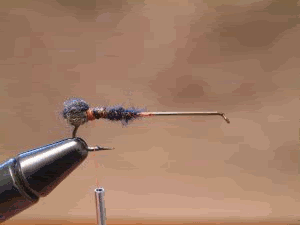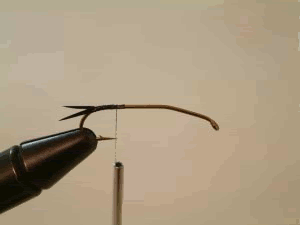
Unlike modern guns that have quick-loading, rapid-firing actions, long range telescopic lenses, and superb reliability, durability, and clean-ability, this old muzzleloader only provides one close-range shot, if the powder stays dry, and if the barrel is clean. It doesn't have a scope, it takes a long time to load and clean, and it's not as accurate.
So why own/hunt with it? Because it only provides one close-range shot, it doesn't have a scope, it takes a long time to load and clean, and it's not as accurate. Really it's the same reason that I hunt with a bow instead of a rifle: It's presents a greater challenge.
To shoot it you have to load everything down the muzzle of the barrel, hence the name: muzzleloader. First you measure and pour the gun powder down the barrel.

Then you place a lead ball on a patch of cloth...

...and shove it down the barrel with the ramrod.

The spark that lights the powder for this style of muzzleloader comes from a percussion cap that you place over a small hole at the back of the barrel.

It is actually made of the same stuff that caps for a child's cap gun are made of. When you pull the trigger the hammer falls and busts the cap, which shoots sparks into the barrel igniting the powder.

The powder ignites and blows up, creating lots of pressure that pushes the ball down and out the barrel toward its target. My buddy demonstrates:
I built the gun myself...well...I sanded, shaped, and stained the stock, blued the barrel, polished the brass, and put it togeher. It came in a kit.

Because I built the gun I know every flaw, like where I sanded it too much or not enough, or how I put the front sight on a little crooked. I remember where I predrilled a screw hole just off center and now one of the screws in the butt plate sticks out a little. I know all its imperfections because I caused them, yet I like that fact. It's more personal, and really it's more rewarding to hunt with a weapon that I helped make. Like fooling a fish with a fly that I tied.
In addition to all of this, there's the rich history behind these guns that really makes it my favorite. If I could take a vacation to any point in time, it would be to the days of frontiersmen and early American homesteaders; to days when cast iron cookware and covered wagons were common, and camp was home rather than an escape from it. Imagine the pictures I'd bring home from that vacation.

In those days a Hawken muzzleloader was the gun to have; the top-of-the-line in firearm technology. I'll tell you more about my passion for that aspect of this gun when I shoot a great plains whitetail with it this coming winter.
























 he named it after the famous bulked-up body builder turned actor and governor. Personally, I would have chosen a different name, but since he created it, it's not mine to change. I gotta give credit where credit is due.
he named it after the famous bulked-up body builder turned actor and governor. Personally, I would have chosen a different name, but since he created it, it's not mine to change. I gotta give credit where credit is due.

